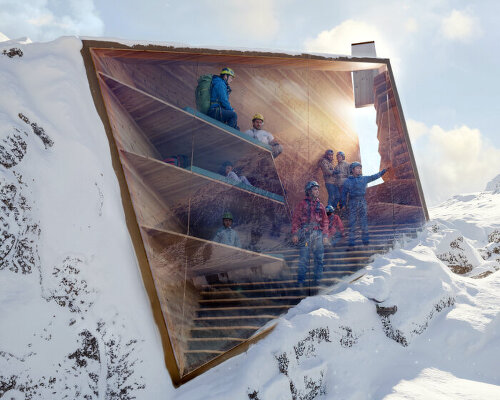Carlo ratti’s alpine structure to debut at 2026 winter olympics
Carlo Ratti Associati introduces the self-sufficient wooden alpine bivouac shelter that can produce electricity and collect water on its own in the Alps. The project is a collaborative work with Salone del Mobile.Milano, which is set to debut as an urban pavilion during the 2026 Winter Olympics in Milan. After that, it is to be moved by helicopter to its permanent place in the Alps to serve as a safe resting point for climbers and trekkers. The main goal of the bivouac shelter is to become a structure that can work by itself in remote mountain areas.
In fact, the one Carlo Ratti Associati has designed can source its own energy, collect its own water, and support basic needs without outside help. It is because the design team used digital technology to study the local environment and build the structure so it fits well into the Alpine setting. They started it with a 3D scan of real rock formations in the Alps, where the scan captured the shape, size, and angles of the rocks to help the designers understand how the natural landscape is formed. Using the data, they designed the shelter’s shape and structure to follow the forms found in the mountain rocks, which made sure the design would fit well with the ground and weather conditions.
all images courtesy of Carlo Ratti Associati
bivouac shelter that handles its own electricity and water
Carlo Ratti Associati’s efforts result in a small prefabricated building made in pieces that can be transported easily, so the design can also be repeated or adjusted for other sites if needed. The bivouac shelter that can handle its own electricity and water uses cross-laminated timber for the main structure to make the remote installations easier when airlifted by helicopter. The team adds aerogel insulation to protect the bivouac shelter against extreme temperatures and a metal layer to strengthen the outer shell and protect the surface from snow, ice, and wind.
Then, there’s a glass front wall that allows natural light to enter and offers a direct view of the surrounding mountains. As mentioned, the bivouac shelter produces its own electricity through a five-kilowatt photovoltaic system placed on the roof. The power is stored in an integrated battery system that keeps the lights, sensors, and digital communication systems working even when there is no sunlight. Because there are no rivers or lakes nearby, the bivouac uses an air condensation system to make drinking water. The system works by cooling air until moisture turns into liquid, and it can produce several liters of potable water per day, enough for a small group of climbers. The structure also includes network connectivity, allowing emergency contact if needed.
the structure also provides space for mountaineers to rest, sleep, and take shelter from weather changes
red warning light that turns on in low-visibility conditions
Traditional mountain shelters are often painted in bright colors to make them easy to find during fog or storms. The team at Carlo Ratti Associati took a different approach because its bivouac shelter that can take care of its own water and electricity matches the tones of its natural surroundings to reduce visual contrast. Instead of paint, it uses a red warning light that turns on automatically in low-visibility conditions. This way, the shelter remains visible when safety requires it but blends with the terrain the rest of the time.
Inside, the structure also provides space for mountaineers to rest, sleep, and take shelter from weather changes during their hike break. The project has two phases. The first phase will take place in Milan during the 2026 Winter Olympics, where the structure will be installed as a temporary pavilion that presents the design to the public. After the event, the bivouac will be dismantled, lifted by helicopter, and transported to its final mountain site. There, it will be reassembled and permanently fixed on the Alpine terrain, becoming the self-sufficient bivouac shelter with its own electricity, water, and essentials.
there’s a glass front wall that allows natural light and offers a direct view of the surrounding mountains
the shelter remains visible when safety requires it but blends with the terrain the rest of the time
the structure is set to debut as an urban pavilion during the 2026 Winter Olympics in Milan
the structure uses a red warning light that turns on automatically in low-visibility conditions
project info:
name: Bivouac
design: Carlo Ratti Associati | @crassociati
event: Milano Cortina 2026
The post self-sufficient bivouac shelter by carlo ratti produces its own water and electricity in the alps appeared first on designboom | architecture & design magazine.

